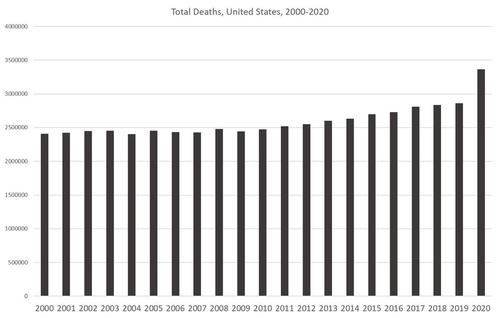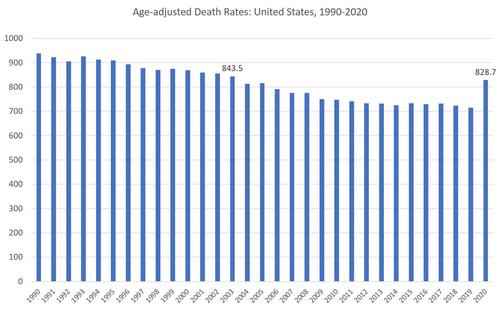Age-Adjusted Mortality At Just 2004 Levels (Despite Media Claims That COVID Is “Worse Than The 1918 Flu”)
Authored by Ryan McMaken via The Mises Institute,
Last week, the media again tried to ratchet up the public’s fear over covid-19 by labeling it more deadly than the 1918 flu epidemic.
“COVID-19 Is Now the Deadliest Disease in U.S. History,” reads one headline from an NBC TV affiliate. Considering the realities of cancer and heart disease, that headline is absurdly false. Perhaps the author meant “communicable disease.”
A TIME headline was at least arguably factual, declaring, “COVID-19 Is Now the Deadliest Pandemic in American History.”
But even the TIME headline is only arguably true if stripped of all context. If we actually look at disease mortality proportionally to the population, the 1918 epidemic was far worse than covid. Considering that the US population in 1918 was one-third its current size, we find that deaths per million from the flu epidemic totaled about sixty-five hundred per million. Covid, by comparison currently comes in—in the official numbers—around twenty-two hundred per million.
But this is all part of a larger pattern—one well embraced by the media—of presenting information with as little context as possible. One such example was the reporting on suicide rates in 2018, which ignored everything but the most recent trend.
A current example—and one very much related to the attempts to compare covid to the 1918 flu—is the failure to look at covid mortality—and mortality in general—in light of an aging population.
Rising Mortality and an Aging Population
After all, the fact that the American population is rapidly aging is going to increase total mortality over time. We see that in the total mortality data over the past twenty years. For example, from 2001 to 2020, total deaths increased in every year but four. It’s unlikely this was because the United States was becoming a more deadly place to live for children or the middle aged. Rather, over that time, the US population became increasingly elderly—and also larger in general—and more people were dying.
This trend appears to have accelerated after 2011, with total annual deaths increasing by 33 percent. Moreover, even if we create a death rate and thus account for increases in total population size, we still find that the death rate has increased in every single year since 2009. Again, we have to wonder if this is because life is more deadly for the general population.
Source: US Centers for Disease Control and Prevention; National Center for Health Statistics.
And, of course, there is the larger increase in mortality that occurred in 2020, thanks—in part—to covid deaths. But this increase occurred in a context of total deaths that was already in an upward trend.
We can get a better perspective on this if we adjust for the aging population. Since the makeup of the population is changing over time, it makes more sense to make comparisons over time using “age-adjusted” total deaths.
Using the Centers for Disease Control and Prevention’s official age-adjusted numbers for total deaths, the trend naturally looks different. Age-adjusted death rates have generally declined for the past twenty years. Indeed, the overall trend has been mostly downward for the past 120 years. (A notable exception was from 1914 to 1918, when the rate increased 18 percent.)
Source: Historical data through 2018 obtained from National Center for Health Statistics Data Visualization Gallery (Mortality Trends in the United States, 1900–2018). Age-adjusted death rates for 2020 obtained from Farida B. Ahmad, Jodi A. Cisewski, Arialdi Miniño, and Robert N. Anderson, Provisional Mortality Data—United States, 2020, Morbidity and Mortality Weekly Report 70, no. 14 (Apr. 9, 2021): 519–22. The report notes: “In 2020, approximately 3,358,814 deaths occurred in the United States (Table). The age-adjusted rate was 828.7 deaths per 100,000 population, an increase of 15.9% from 715.2 in 2019.”
So what does this added context tell us?
For one, it tells us the comparisons to 1918 are quite inappropriate. Age-adjusted deaths increased by more than 265 per hundred thousand from 1917 to 1918. The same rate increased by 113 per hundred thousand from 2019 to 2020.
Moreover, looking more closely at the past twenty years, we find that the increase from 2019 to 2020 takes us back only to somewhere between 2003 and 2004 in terms of comparable rates. Anyone over the age of twenty-five who remembers those days may recall that the period was not considered to be a time of unprecedented health crises.
Source: Centers for Disease Control. Historical data through 2018 obtained from National Center for Health Statistics Data Visualization Gallery (Mortality Trends in the United States, 1900–2018). Age-adjusted death rates for 2020 obtained from Farida B. Ahmad, Jodi A. Cisewski, Arialdi Miniño, and Robert N. Anderson, Provisional Mortality Data—United States, 2020 Morbidity and Mortality Weekly Report 70, no. 14 (Apr. 9, 2021) 519–22.
The point here, of course, is not that covid deaths over the past eighteen months are insignificant. Indeed, even if we make no distinction between covid deaths and noncovid deaths since early 2020, it’s clear more Americans have indeed been dying from all causes. And that’s hardly something to celebrate or ignore. Nevertheless, it remains important to obtain some much-needed context when examining a disease which is being used to justify unprecedented increases in state power and violations of human rights.
American citizens are nowadays subjected to a nonstop drumbeat of claims about “unprecedented” levels of mortality.
We’re even told covid is just like the flu of 1918.
And to what end?
Apparently, to rob people of their livelihoods if they refuse to receive a vaccine. It’s to attempt to make pariahs of anyone who makes health decisions of which the regime does not approve. It’s to continue to justify 2020’s ineffectual lockdowns. It’s to justify government spending at levels unprecedented in peacetime. It’s to deny that natural immunity provides meaningful resistance to the disease.
Yet all this rhetoric occurs at a time when age-adjusted mortality is not exactly panic inducing if we look beyond the confines of just the last few years.
Tyler Durden
Thu, 10/14/2021 – 14:00
via ZeroHedge News https://ift.tt/2XgPex8 Tyler Durden



